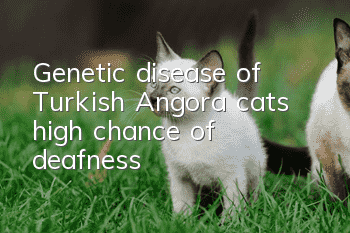Genetic disease of Turkish Angora cats: high chance of deafness

The Turkish Angora cat has a long history and is one of the oldest long-haired cats. This cat has a relatively independent personality, so it doesn't like to be petted or picked up very much, so it may not be a good choice for owners of cats who like to be close to people. Moreover, this kind of cat has a relatively frequent genetic disease, which is deafness, which may have a certain impact on its life.
Turkish Angora cats have a long history, and some experts even believe that they are the ancestors of all modern long-haired cats. Some modern people still believe that they are descendants of wild rabbit cats in Central Asia. Legend has it that the Tatars once fed wild domesticated rabbit cats and then brought them to Turkey. The Turkish Angora cat, which has been favored for centuries, is also called the Ankara cat, named after the old name of the Turkish capital Ankara - Angora.
The earliest records and origins of them in the book come from the 16th century. People believe that they should have originated from the colder areas of Turkey. Turkish Angora cats with black coats must be completely black, and they are pure black from the root to the tip of the hair. of. The process of civilianization of aristocrats. After World War II, breeders in Sweden, the United Kingdom and the United States introduced Turkish Angora cats from Turkey and began multi-blood mixed breeding. Today, Turkey has strictly protected this variety, and even in Turkey's own breeding center, it must be bred under strict management.
Turkish Angora cats are somewhat talkative, but this is also a sign that they like to communicate with people. White Is Preferred, Color Is Fashionable Although the most impressive and admired breed is the white Turkish Angora cat, they actually come in a wide range of colors. The previous standard only recognized white, and the coat was white and solid, without stripes or spots. As people continue to breed, various solid colors, tortoiseshell colors and markings are now recognized. The Turkish Angora cat is a small to medium-sized cat with a sturdy body covered with a single layer of medium-long coat, which is very shiny. But this kind of cat has such a hereditary disease.
Before Persian cats became popular in Europe, Turkish Angora cats were the most popular long-haired cats. The traditional Angora cat is slender and slender, with white fur and mostly blue or yellow eyes. But when white fur meets blue eyes, it means a congenital physical defect: deafness.
Most white cats with blue eyes have a high chance of becoming deaf. If it is a white cat with mandarin duck eyes, the ear corresponding to the blue eye will also be deaf. This is because the W gene that controls cat coat color also affects the development of the inner ear cochlea and iris pigment. However, compared to other health problems, deafness can be regarded as a problem that has the least impact on cats.
However, it is worth noting that genetic diseases in Angora cats are not easy to detect. But no matter when, as long as the owner finds that heIf your Angora cat has hearing problems, or does not respond at all to some noises, then it is very likely that your cat has congenital deafness, and owners should pay attention to this problem. Take your cat to a pet clinic promptly for diagnosis, treatment, and rehabilitation. The earlier it is discovered, the greater the chance of cure.
- Do cats have better hearing than dogs?
- Why does the cat meow when its owner leaves?
- The cat’s meow is so small that I can’t feel it coming out.
- Preventing Garfield’s tear stains in terms of care
- Why do pet cats urinate everywhere at home?
- Can cats eat durian?
- What should I do if my kitten has diarrhea and vomiting after eating too much?
- How to feed canned cats?
- Is it normal for kittens to have bad breath?
- Does the cat need to be walked? What should you pay attention to when walking your cat?



